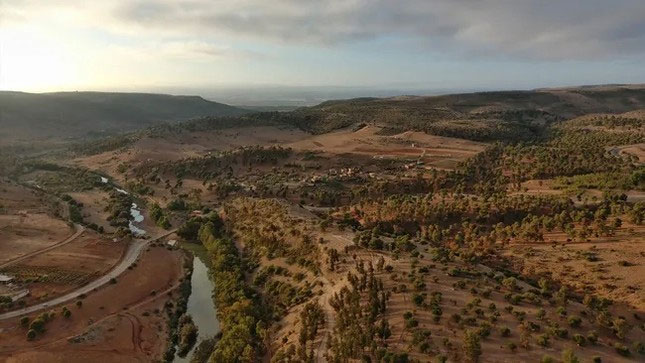Remains of 5,000-year-old agricultural society as large as ancient Troy discovered
Archaeologists in Morocco have discovered the remains of a 5,000-year-old farming society , the oldest site ever discovered in Africa outside the Nile Valley.
Thousands of stone axe heads and painted pottery fragments found at the site reveal a previously unknown society of hundreds of people – comparable in size to Bronze Age Troy – who may have lived together, farmed the land and traded with other societies across the Mediterranean.

An aerial view of the Oued Beht archaeological site. (Photo: Toby Wilkinson, OBAP Archive).
The Oued Beht archaeological site in northern Morocco was discovered by French colonialists in the 1930s. After the site had been neglected for 90 years, Moroccan archaeologist Youssef Bokbot had a hunch that there might be important discoveries just below the surface and contacted other experts to collaborate on the excavation.
The study, published in the journal Antiquity, revealed 'a large number of ceramic fragments and polished axes ,' said study co-author Giulio Lucarini, an archaeologist at the Institute for Heritage Sciences of the Italian National Research Council.
By radiocarbon dating charcoal samples and seeds found during excavations, the team dated the site to around 3400 to 2900 BC.
The groups that lived there may have had a variety of genetic backgrounds. According to a 2023 study co-authored by Bokbot, traditional pastoralists from the Sahara, as well as people originally from the Iberian Peninsula and the Middle East, may have settled in the area.
The people who lived at the site were farmers who grew barley, wheat, peas, olives and pistachios on the arid land, according to evidence of seeds found in large pits that were built. The team also unearthed the remains of sheep, goats, pigs and cattle at the site.
Additionally, the abundance of pottery and stone axe heads found at the site suggests that these Neolithic groups produced goods to trade with many other Bronze and Bronze Age societies that existed at this time, such as those in the Iberian Peninsula and potentially Egypt and Mesopotamia.
Other studies have shown the presence of ivory and ostrich eggs in Europe during this time, but to date, archaeologists have no evidence to suggest which African societies may have supplied these items to Europe.
Like sub-Saharan Africa at this time, North Africa was largely inhabited by hunter-gatherers and pastoralists, nomadic people who followed the herding routes. And while settled agricultural societies of this period have been found throughout the rest of the Mediterranean, North Africa has been overlooked as an archaeological resource.
- Discovered the remains of the ancient city built by the former Trojan prisoner
- The 3,000-year-old statue in Turkey reflects feminism
- Troy has never been a busy city?
- Unearth Troy
- Rediscover the 6,500-year-old remains
- Mexico studied 30 sets of ancient remains
- Troy ruins ruins on the hill of Turkey
- Discovered 5,000-year-old remains covered with ocher color in Siberia
- Discovered the 2,000-year-old remains of 'Sleeping Beauty in the Forest' in Ethiopia
- 9,000-year-old remains reveal the collapse of the old city
- Shocking the 'bird' remains in 5,000 year old tombs
- Discover the remains of women bent over 4,000 years in the grave
 Discovered an ancient centipede fossil 99 million years old
Discovered an ancient centipede fossil 99 million years old Discovered bat-like dinosaurs in China
Discovered bat-like dinosaurs in China Discovered a 200-year-old bronze cannon of the coast
Discovered a 200-year-old bronze cannon of the coast Discover 305 million-year-old spider fossils
Discover 305 million-year-old spider fossils